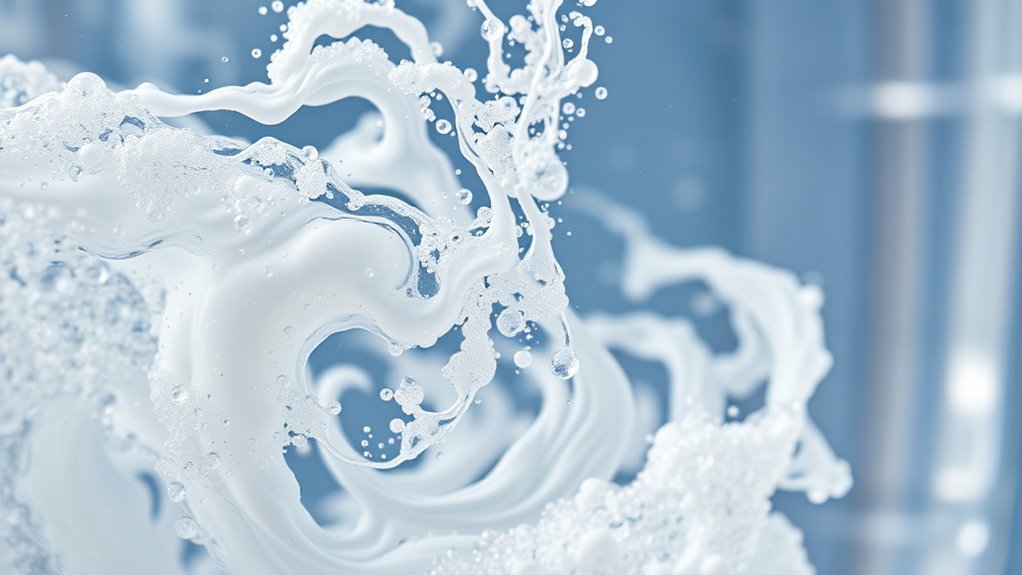Water-soluble stabilizers are best used when you need to keep ingredients evenly dispersed and prevent separation over time. You should add them when formulating products like cosmetics, food, or pharmaceuticals, carefully dissolving them in cold water if suitable. Make sure to measure and mix thoroughly for complete dissolution. Proper use enhances stability, appearance, and effectiveness. For detailed guidance on application techniques and ideal integration, keep exploring the topic further.
Key Takeaways
- Use water-soluble stabilizers when aiming to prevent ingredient separation and improve product uniformity.
- Dissolve stabilizers in cold water to maintain formulation stability, especially for sensitive ingredients.
- Apply stabilizers during formulation by measuring accurately and mixing thoroughly for complete dispersion.
- Select stabilizers based on formulation pH, temperature, and active ingredient compatibility for optimal effectiveness.
- Incorporate stabilizers to extend shelf life, enhance appearance, and ensure consistent product performance over time.

Have you ever wondered how certain substances stay stable and dissolve easily in water? Water-soluble stabilizers are essential tools in many formulations, helping you achieve consistency, enhance stability, and improve the overall performance of your products. Understanding when and how to use these stabilizers can make a significant difference in your formulation process. The key lies in knowing the right application techniques and recognizing the formulation benefits they offer.
When you incorporate water-soluble stabilizers, you guarantee that your ingredients remain evenly dispersed and resistant to separation over time. These stabilizers work by forming a protective matrix around active compounds, preventing degradation or phase separation. Application techniques are critical here; you need to carefully choose the right stabilizer for your specific formulation, considering factors like pH, temperature, and the nature of your active ingredients. For example, some stabilizers dissolve readily in cold water, making them ideal for sensitive formulations, while others require heating to fully activate their stabilizing properties.
The formulation benefits of water-soluble stabilizers are numerous. They improve the homogeneity of your mixture, which is essential for ensuring uniformity in each dose or application. They also extend the shelf life of your product by preventing crystallization or precipitation, maintaining clarity and consistency. Furthermore, these stabilizers can enhance bioavailability and absorption, making your products more effective. This is particularly important in pharmaceuticals, cosmetics, and food products, where stability directly impacts efficacy and consumer trust. Additionally, selecting the appropriate stabilizer can influence color fidelity and overall visual appeal in formulations.
Using the correct application techniques involves precise measurement, thorough mixing, and sometimes, pre-dissolving the stabilizer before adding it to your formulation. You should follow recommended concentrations, typically provided by manufacturers, to avoid over-stabilization, which can affect texture or clarity. In some cases, you might need to adjust your process parameters, like stirring speed or temperature, to ensure complete dissolution and proper integration. Proper application not only maximizes the stabilizer’s benefits but also prevents issues like clumping or incomplete stabilization.
Frequently Asked Questions
Can Water-Soluble Stabilizers Be Reused After Initial Use?
You might wonder if water-soluble stabilizers can be reused after their initial use. Their reusability potential depends on proper cleaning and handling, but contamination risks increase with reuse. If you decide to reuse them, thoroughly rinse and dry the stabilizers to minimize bacteria or residue buildup. However, keep in mind that repeated use could compromise their effectiveness, so weigh the benefits against potential contamination risks before reusing water-soluble stabilizers.
Are Water-Soluble Stabilizers Compatible With All Types of Formulations?
You’re wondering if water-soluble stabilizers are compatible with all formulations, right? The truth is, compatibility concerns can arise, requiring careful formulation adjustments. Not every product reacts the same way, so testing is essential. While they’re versatile, you must evaluate each formulation’s unique ingredients to guarantee stability. Ignoring these nuances might compromise your product’s quality, so stay vigilant, adapt as needed, and always test thoroughly before full-scale use.
How Do Water-Soluble Stabilizers Impact Product Shelf Life?
You might wonder how water-soluble stabilizers affect your product’s shelf life. They help by reducing product degradation and enhancing microbial stability, which prevents spoilage. When used correctly, these stabilizers can extend shelf life, keeping your product fresh longer. However, improper use may lead to instability or microbial growth. So, understanding their proper application guarantees your formulations stay effective and safe over time.
What Are the Environmental Considerations of Using Water-Soluble Stabilizers?
You might worry about environmental impacts, but water-soluble stabilizers are generally biodegradable, reducing long-term waste. However, be aware of biodegradability concerns and potential aquatic toxicity; some stabilizers can harm aquatic life if not properly managed. To minimize risks, choose eco-friendly options and follow disposal guidelines. This approach helps protect ecosystems while benefiting from stabilizers’ advantages in product stability and shelf life.
Do Water-Soluble Stabilizers Require Special Storage Conditions?
You need to pay attention to storage requirements for water-soluble stabilizers to maintain their shelf stability. Keep them in a cool, dry place away from direct sunlight and moisture, as these conditions can affect their effectiveness. Proper storage guarantees they stay effective over time, preventing clumping or degradation. By following these guidelines, you’ll ensure your stabilizers remain usable and effective when needed, saving you time and money.
Conclusion
Water-soluble stabilizers are your secret allies, like gentle guardians that keep your creations steady and vibrant. When you need clarity, flexibility, or a touch of magic, reach for them confidently. They’re the unsung heroes that turn chaos into harmony, transforming your work into a masterpiece. Embrace their subtle power, and watch your projects flourish like a blooming garden after a gentle rain—beautiful, resilient, and full of promise.









